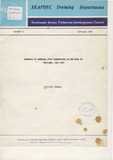| dc.description.abstract | The demersal fish stocks In the Gulf or Thailand have been intensively studied since the exploitation of these fisheries started in the early 1960 ‘s. Investigations by otter board trawl have been conducted annually by the research vessels of the thai Department of Fisheries since that time. The major species groups, in terms of kilograms per trawling hour of the research vessels , have been compiled since 1963.
The demersal fishes in the Gulf of Thailand, as well as those in other tropical areas, consist of many species. It is said that there are more than 300 demersal fishes species attributed to these fisheries. Although some species are grouped for the sake of simple analysis, there are still 18 major species groups
(SOMMANI 1983).
Studies of the fish stocks have been conducted intensively both in terms of the biology and the dynamics of the stock and their fisheries. Species composition is also an interesting topic that has been reported on by many authors such as TUEWS et al. (1967), EIAMSAARD et al. (1979), EIAMSAARD and DHAMNIYOM (1989 and 1981) and CHARNPRASERTPORN (1982). These authors, however, considered only the species composition of the catch, not the fish community.
In this paper, attempts have been made to monitor the changes in the demersal fish community be considering the species group composition, calculated using the estimated stock size indices. The fishes are separated here into four main groups, plus one other called “the Others”. They are as follows :
a) The Large predator group includes two species i.e. Sharks and Serranidae.
b) The Large zoobenthos feeders are composed of Rhinobathidiae and Rays.
c) The Intermediate predators include Psettodes erumei, LutJanidae, Priacanthus, Synodontidae, Sphyraena, Carangidae, Plectorhychidae and Pomadasys.
d) The Small prey group includes four species groups, namely; Scolopsis, Mullidae, Leiognathidae and Gerridae, and Nemipterus
e) “The Others” include the other good fishes and the trash fishes.
Except for the last group, it should be noted that this is a similar grouping to that of Pauly (1979).
The nine sampling areas in the Gulf of Thailand , as defined by the Marine Fisheries Division of the Thai Department of Fisheries, are combined and redefined into three areas as shown in Figure. 1.
1. The Northern part of the Gulf includes the East, The Inner and a part of the upper areas of the Western Gulf i.e. Areas 1, 2, 3 and 4 in the aforementioned papers.
2. The Central part covers Areas 5, 6 and 7.
3. The Southern part covers Areas 8 and 9 and is the same as in SOMMANI’s (1983) report. | en |

